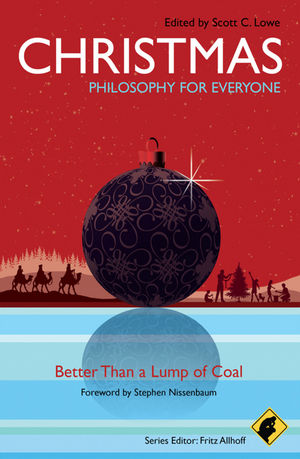Christmas - Philosophy for Everyone: Better Than a Lump of CoalISBN: 978-1-4443-3090-8
Paperback
256 pages
September 2010, Wiley-Blackwell
 |
||||||
Connect with Wiley Publicity
“Not so much a subject matter, philosophy is a way of thinking. Thinking not just about the Big Questions, but about little ones too. This series invites everyone to ponder things they care about, big or small, significant, serious … or just curious.”—Philosophy for Everyone
A lonely winter night, a young village couple, the son of God, a few barnyard animals, and some holy men, and you have the story of Christmas—at least according to the Bible. Secular tradition, however, sees it as a time to be merry and indulge in rich food, drink, and gifts, which aligns with the original Winter Solstice and harvest tradition. Christmas: Better Than a Lump of Coal (October 2010) looks deeper into the Christmas festivities to unwrap its pagan origins and secular trimmings.
The essays cover everything from consumer madness, culture wars, the Puritan ban on Christmas, Ebenezer Scrooge (“Scrooge Learns it All in One Night: Happiness and the Virtues of Christmas”), a tongue in cheek treatment of the labor exploitation of elf workers (“Santa's Sweatshop: Elf Exploitation for Christmas”), the beloved Christmas Story movie (“Crummy Commercials and BB Guns: Son-of-a-Bitch Consumerism in a Christmas Classic”), and Santa Claus himself (“Against the Santa Clause Lie: The Truth We Should Tell Our Children” & “Lying to Children about Santa: Why It's Just Not Wrong”).
There are a host of philosophical and cultural issues surrounding the practices and beliefs of Christmas, and Christmas: Better Than a Lump of Coal (October 2010) offers thoughtful and humorous philosophical insights into the most widely celebrated holiday in the Western world. The contributors engage in a sparring match between the merits of the Christmas tradition on a secular and pious level, and pit the two main representative figures of the holiday against each other (Santa Claus and Jesus) in an ongoing contest of goodness, generosity, and mythical relevance.
Some would argue that Santa is the more identifiable leader of Christmas cheer, and that the Christian sentiment has largely fallen by the wayside, among the discarded wrapping paper and cracked tree ornaments. In “Making a List, Checking It Twice: The Santa Claus Surveillance System” and “You’d Better Watch Out,” the contributors question the premise of Santa Claus as an actual being, and the underlying psychological motives behind his presence in the holiday tradition. In the Afterword, Santa Claus, the right jolly man himself is given the chance to defend himself (and straighten out his reputation as the descendent of the gods Thor , Odin, and the sinister Krampus), leading to the conclusion that the contributors who argue his existence may very well find a lump of coal in their stocking this coming season.
Some of the essays argue that the literal telling of the Christmas story in the Bible is false, and misguided (“Jesus, Mary and Hume: On the Possibility of the Virgin Birth”) while others see it as an illustration of the power of the Bible to teach important spiritual lessons (“The Virgin Birth: Authentic Christmas Magic” and “Christmas Mythologies: Sacred and Secular”).
With some having visions of a tide of anti-Christmas sentiment (the supposed “War on Christmas”) and the counterattack from conservative or fundamentalist Christians and media talking heads (Bill O’Reilly), the mere mention of Christmas has become a sore spot in society. In “Armed for the War on Christmas” and “The Significance of Christmas for Liberal Multiculturalism,” the contributors play out the two sides of the argument, challenging the reader to pick a side, or simply unite behind Christmas as a unifying force among diverse religions and cultures.



